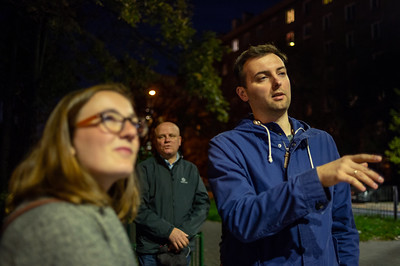Study visits
Also known as: Peer-learning visit, mentoring visit, knowledge sharing visits, city workshops, capacity building weeks
A ‘study visit’ is an umbrella term for any instance when a city hosts one or more cities to exchange knowledge on a subject. Though some online versions of study visits were held during the pandemic, this is predominantly, indeed at its core, an in-person method.
Study visits offer groups of experts, decision makers and/or other stakeholders from one or more cities the opportunity to visit another city and see first-hand how the latter has successfully implemented its plans, policies, projects and/or initiatives, as well as what challenges it is still facing and how it has dealt with failures.
Structured around a mix of practical and theoretical activities, the study visit offers the visitors the opportunity to see in practice how projects are implemented and learn from the host city.
These visits bring challenges and approaches to life, ensure a dynamic and interactive exchange of experience and knowledge between participants and allow them to get a better and more practical understanding of local projects and initiatives through direct interaction with key local stakeholders and decision makers.
These visits consist of discussions, meetings (internal members and external guests), site visits and other elements, and represent a great learning opportunity for cities. Although the visitors are the main beneficiaries of a study visit, it has many benefits for the host city as well (see the ‘outcomes’ section below).
Study visits usually last between one-and-a-half to three days. They are at the core of most knowledge sharing methods.
Method
- Identification of participants: Participants can be chosen through an open call or as part of a specific project.
- Choosing a focus: Organisers should ascertain the primary objectives of the visit. This can be based on participant feedback via surveys or interviews, or predefined strengths and needs associated with the overarching project.
- Introduction and preliminary engagement: Before the actual visit, both host and visiting participants should interact through online calls to understand mutual expectations and contexts. Sharing of media, like documents or videos, further enriches this preliminary interaction.
- Logistics and scheduling: Organisers should decide upon the dates and share vital details such as accommodation, venues, and meal arrangements well in advance.
- Participant composition: While the typical delegation comprises one or two representatives from each city, the actual number can vary. Participants can range from city experts, decision-makers, to different types of local stakeholders. Primarily, participants should be individuals poised to leverage the acquired knowledge to effect tangible change in their respective cities.
- Content of the visit: Combining practical on-the-ground observation with theoretical sessions, participants get a holistic understanding of the host city’s projects, successes, and challenges.
Application in Specific Projects:
Eurocities’ EU-funded Prospect+ project:
-
- Preparation: This project integrated four preparatory online meetings. It also mandated collaborative completion of an online action plan, which was updated post-visit.
- Onboarding & training: The initial online meeting introduced hosts and participants, discussing key themes. Subsequent online sessions trained host cities in effective mentoring and allowed mutual sharing of best practices and ongoing projects.
- Physical visit structure: The first day predominantly involved discussions and meetings, whereas the second day combined site visits with wrap-up sessions where participants shared their lessons and planned subsequent steps.
- Post-visit engagement: A follow-up online meeting allowed visitors to discuss their progress and seek additional guidance.
Culture for Cities and Regions Project:
-
- Collaborative reporting: After each visit, hosts and visitors jointly created an analytical document that captured the essence of their interactions.
- The report comprised an executive summary highlighting key findings and discussions.
- An analytical section detailed the visit and its pivotal moments.
- Feedback from participants and hosts provided an introspective lens on the content and overall visit dynamics.
- Collaborative reporting: After each visit, hosts and visitors jointly created an analytical document that captured the essence of their interactions.
The design and structure of study visits are inherently flexible, allowing for tailored experiences that address the unique needs and objectives of participating entities.
Top tips
Key for structuring the study visit is a red thread: making sure the different parts of the programme build on each other and that there is an overall balance of the programme.
Sites visits are at the heart of the programme and are ideally always associated with transferability sessions, in which the content of the site visit is critically analysed, the transferability of the elements seen, assessed.
For the practical activities on site, walk and talk methodologies can be applied to stimulate discussion and catch the impression from participants while they discover a given urban space. For all transfers from one site to the another and all other things being equal, consider the safest and less traffic-intensive routes.
Short presentations help introduce participants to a measure or a specific context. The site visits constitute the key moment where attendees see and experience the policy or measure. The closing transferability discussions allow to take a critical step back, give feedback, ask questions and assess the transferability of the projects and measures seen. These are a particularly important but often overlooked aspect.
Pros & cons
Pros:
- This method allows participants to view successfully implemented projects/initiatives/measures, learn more about the context and the history of any given project, get an overview from planning to implementation as well as the challenges and barriers encountered along the way and how they were overcome.
- Rather easy to arrange and to attract participants if well focused; Huge interest from hosts and participants, allowing for rich agendas and high-quality sessions.
- Overall project evaluation in the AMIF-funded Eurocities project, ‘Integrating Cities’ showed the study visits part was the most appreciated by cities.
- Allows informal yet essential discussions between participants and encourages long-term partnerships.
Cons:
- Study visits relay a lot on the facilitator. It is essential the host and visitors are well pared.
- One or more participants dropping out close to the event can really put a spanner in the works.
- The visit will not be a success if the projects presented are too context dependent and are not applicable to other local contexts.
Outcomes and impact
Visitors get a tangible sense of the successes of the host city, and understand the nuances of their practices. They have time to consider the practices, and how they are integrated in the wider activities of the city. The relationships formed on visits are often long-lasting, and open direct lines of communication between peers working on similar topics across Europe, which are often exploited further in the future.
The host city has the opportunity to showcase itself and demonstrate its successful projects and initiatives to visitors. Confronting and discussing their policies and measures with counterparts from visiting cities allows them to shed a new light on their own achievements and see them from a different perspective. New and critical ideas from visitors can help the host city to further improve its projects and initiatives.
Impact
After an intensive exchange with Cologne during one of Eurocities’ CIVITAS SATELLITE study visits, Bristol is establishing mobility hubs locally. Data shared by Cologne helped Bristol demonstrate how mobility stations have moved people away from car use, exactly the evidence base that Bristol was looking for.
A Culture for Cities and Regions visit in 2015 to Bologna22 inspired Chemnitz to adapt the INCREDIBOL23 initiative, a model for promoting creative activities and conversion of vacant building and empty spaces into cultural spaces. Bologna, like Chemnitz has a lot of unused space and a desire to revitalise urban districts through cultural development. After the visit, Chemnitz created and launched in 2018 the programme KRACH (Kreativraum24 Chemnitz) to support innovative projects of the cultural and creative industries scene by offering commercial space, a start-up budget and expert support in business, law and marketing to sponsored projects.
After a Culture for Cities and Regions visit in Sofia, the city of Lincoln established an Art Innovation fund (‘Lincoln Creates’) which draws on the experience and lessons from the city of Sofia. The fund encourages artists and local businesses to collaborate on projects to make the city centre more attractive, with Lincoln Business Improvement Group helping to facilitate these relationships.
Pitfalls
The matching of the cities and focus of the visit: The added value largely depends on the quality of the matching, including the transferability potential resulting from similar local context (available policy incentives, matching regulations, etc).
The content of the visit and type of knowledge shared during them may not meet the visitors’ expectations, objectives and learning needs due to a poor matching or a bad management of expectations. Organisers should make sure that the best practices presented during the visits are as interesting as possible for the visitors, advanced enough in their implementation, and aligned with their objectives and plans. This is also a reputational problem, especially as the offered reimbursement amount rarely covers all costs spent by the visiting participants.
The challenges also include the varying objectives across the participants resulting from the differences in their local context, including local regulations, needs resulting from geographic location, etc. This requires careful planning by organisers to prepare an agenda that would address everyone’s needs while fitting the purpose of the visit.
Ideally, most of the work involved in organising a study visit should be taken care of by the host, but in practice it often falls on the organisers to make sure that everything has been considered and planned correctly.
The transferability/ replicability potential of the host’s projects/ best practices should be assessed before the visit to make sure it meets participants’ practical expectations and learning needs and that the exchange achieves impact.
The selection of the facilitator: The role of the facilitator is also critical in the process: in analysing the practices shared, allowing practical, valuable and tailored exchanges, and identifying whether the mentees would reach their objectives. Eurocities often acts as a facilitator during the visits.
Follow up: Participants are contacted several months after the visit to share on what has changed in their city following the visit. It is difficult to get replies and to keep track of and evaluate the changes.
The Digital/Online format: Although it makes it possible for a more significant number of cities to participate and reduces the logistical constraints on organising events, the online format does not guarantee active and constant participation. Indeed, as participants do not necessarily dedicate time to the visit, as they might for an in-person visit, digital solicitations, emails and interruptions are frequent. There is a need to strengthen interactivity to unravel different aspects of discussion and dedicate time to informal exchanges.
Links
Read a report produced by a productive study visit from our Cultural Heritage in Action project here.
Read more about the study visit methodology on page 13 of this document from our Fast Track project.


